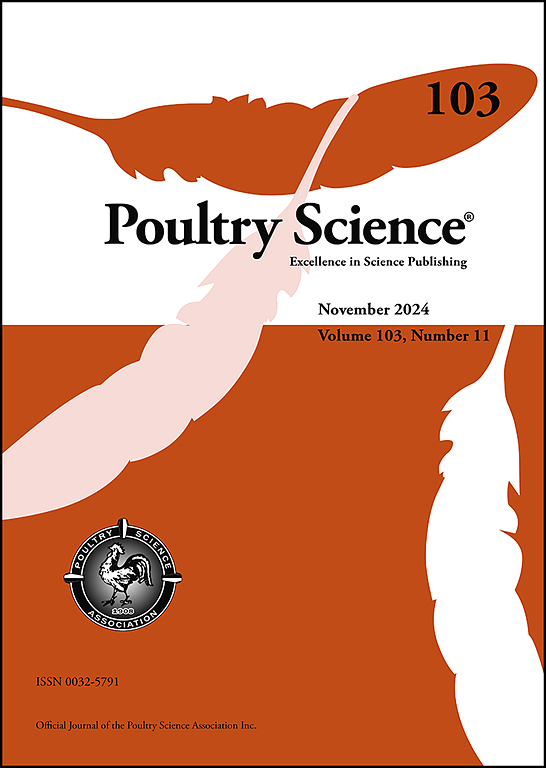Investigation of the effect of heat stress on egg production traits in Thai native chickens (Lueng Hang Kao Kabin) as determined by the temperature-humidity index
IF 3.8
1区 农林科学
Q1 AGRICULTURE, DAIRY & ANIMAL SCIENCE
引用次数: 0
Abstract
Heat stress is a considerable challenge for the poultry industry, impacting even native breeds well-known for their adaptability. This study aimed to examine the effect of heat stress, defined as a temperature-humidity index (THI), on egg production traits in Thai native chickens (Lueng Hang Kao Kabin breed, LHKK). The THI values were calculated using three different equations based on the weather data on the same day (day 0) as the observation and up to seven days (day -7) prior to the observation. The models were preliminarily tested to identify the significant effects on egg production traits based on adjusted R2, residual error variance, and Akaike Information Criterion (AIC) values. The most impactful day of each THI was determined based on the absolute value of the greatest regression coefficient. These days were then analyzed to identify the THI breakpoint associated with a decline in egg production traits. Heat stress had a significantly negative effect on egg production traits in LHKK chickens. THI values effectively captured the impact of heat stress on these traits, with day -3 and day -1 prior egg laying exhibiting the strongest influence on egg weight at first egg and egg weight, respectively. The THI breakpoints for significant declines in egg weight at first egg were found to be higher than those for egg weight. The current findings suggest that heat stress should be considered as a significant variable in models of egg production traits in native chickens.
用温湿指数测定热应激对泰国土鸡产蛋性状的影响
热应激对家禽业来说是一个相当大的挑战,甚至影响到以适应性而闻名的本土品种。本研究旨在研究热应激(定义为温湿度指数(THI))对泰国土鸡(Lueng Hang Kao Kabin品种,LHKK)产蛋性状的影响。THI值是根据观测当天(第0天)和观测前7天(第7天)的天气数据,使用三个不同的方程计算得出的。根据调整后的R2、残差方差和赤池信息准则(Akaike Information Criterion, AIC)值对模型进行初步检验,以确定对产蛋量性状的显著影响。根据最大回归系数的绝对值确定各THI影响最大的日子。然后对这些天进行分析,以确定与产蛋性状下降相关的THI断点。热应激对LHKK鸡产蛋性状有显著的负面影响。THI值有效地反映了热应激对这些性状的影响,产蛋前第3天和第1天对首蛋和蛋重的影响最大。发现首次产蛋时蛋重显著下降的THI断点高于蛋重。目前的研究结果表明,热应激应被视为土鸡产蛋性状模型中的一个重要变量。
本文章由计算机程序翻译,如有差异,请以英文原文为准。
求助全文
约1分钟内获得全文
求助全文
来源期刊

Poultry Science
农林科学-奶制品与动物科学
CiteScore
7.60
自引率
15.90%
发文量
0
审稿时长
94 days
期刊介绍:
First self-published in 1921, Poultry Science is an internationally renowned monthly journal, known as the authoritative source for a broad range of poultry information and high-caliber research. The journal plays a pivotal role in the dissemination of preeminent poultry-related knowledge across all disciplines. As of January 2020, Poultry Science will become an Open Access journal with no subscription charges, meaning authors who publish here can make their research immediately, permanently, and freely accessible worldwide while retaining copyright to their work. Papers submitted for publication after October 1, 2019 will be published as Open Access papers.
An international journal, Poultry Science publishes original papers, research notes, symposium papers, and reviews of basic science as applied to poultry. This authoritative source of poultry information is consistently ranked by ISI Impact Factor as one of the top 10 agriculture, dairy and animal science journals to deliver high-caliber research. Currently it is the highest-ranked (by Impact Factor and Eigenfactor) journal dedicated to publishing poultry research. Subject areas include breeding, genetics, education, production, management, environment, health, behavior, welfare, immunology, molecular biology, metabolism, nutrition, physiology, reproduction, processing, and products.
 求助内容:
求助内容: 应助结果提醒方式:
应助结果提醒方式:


